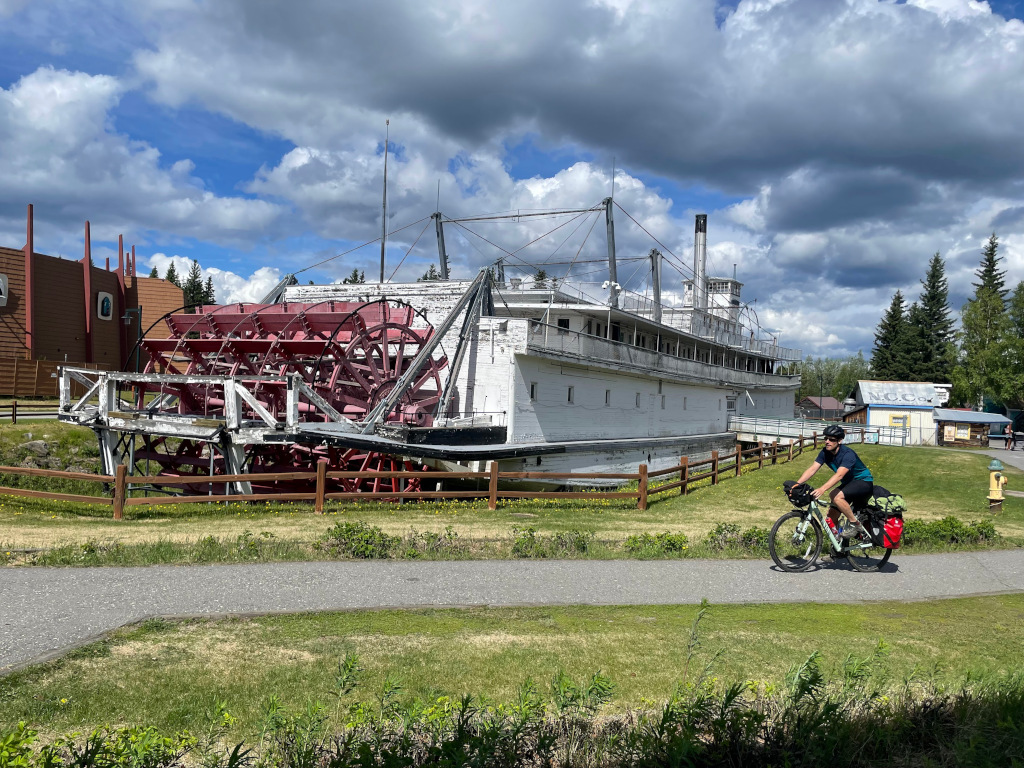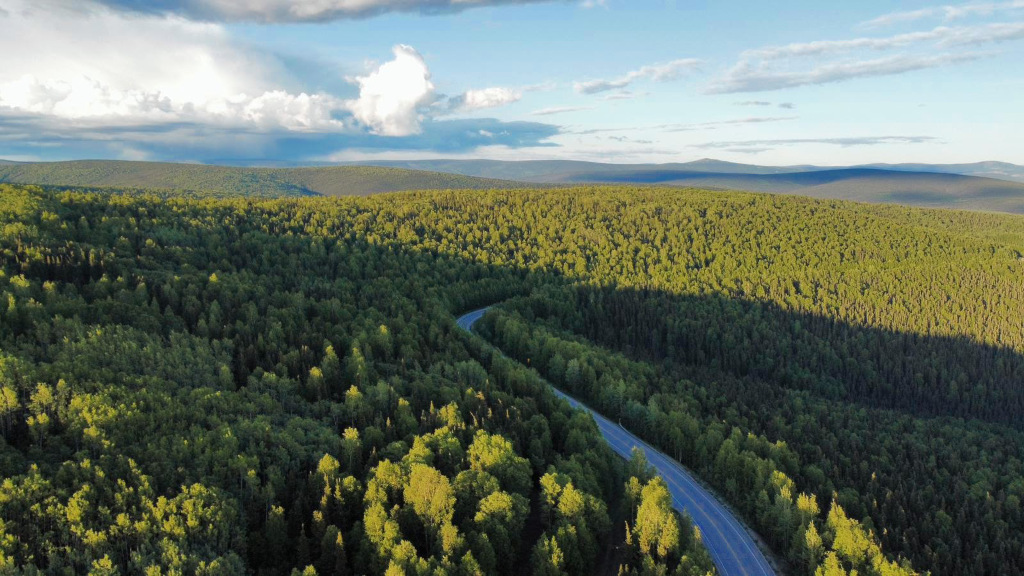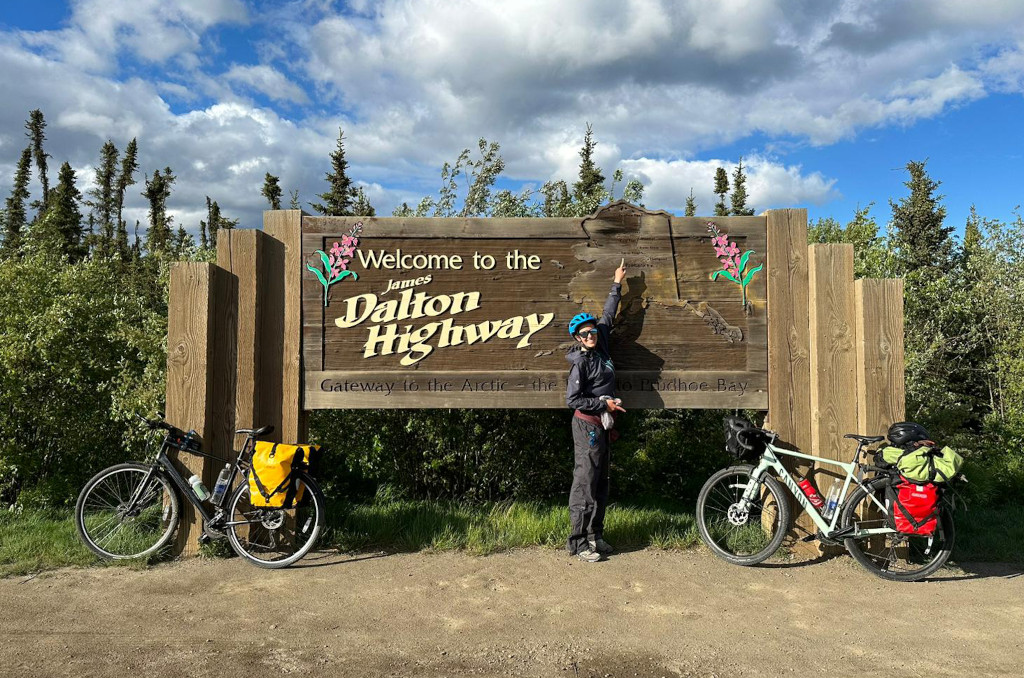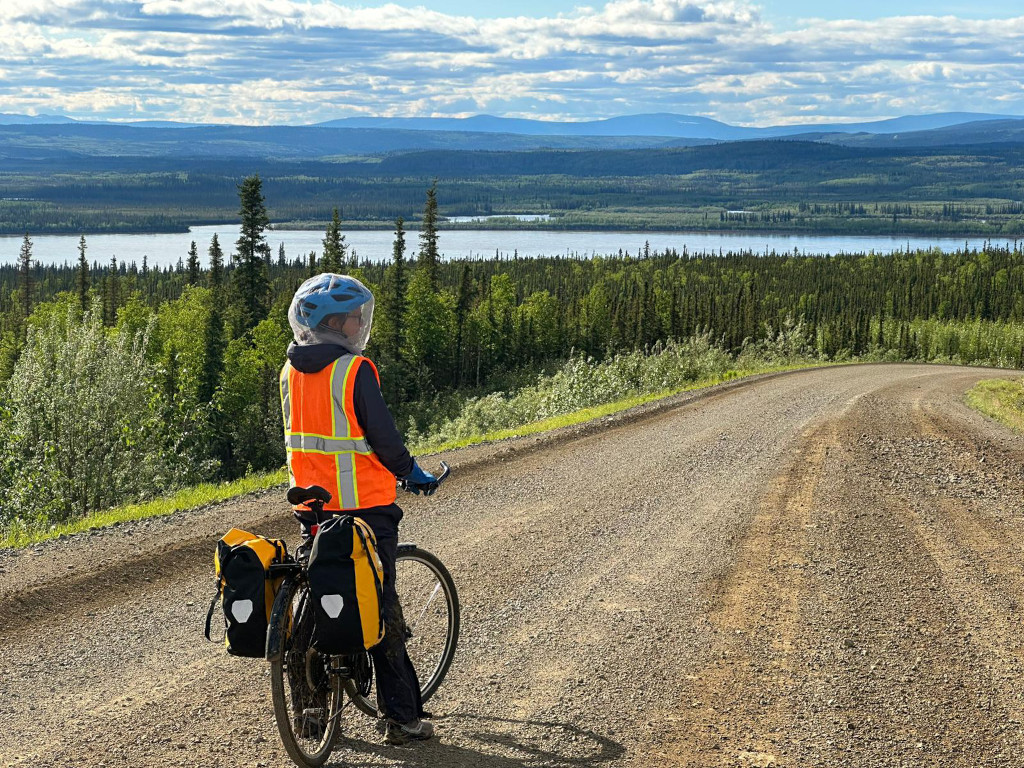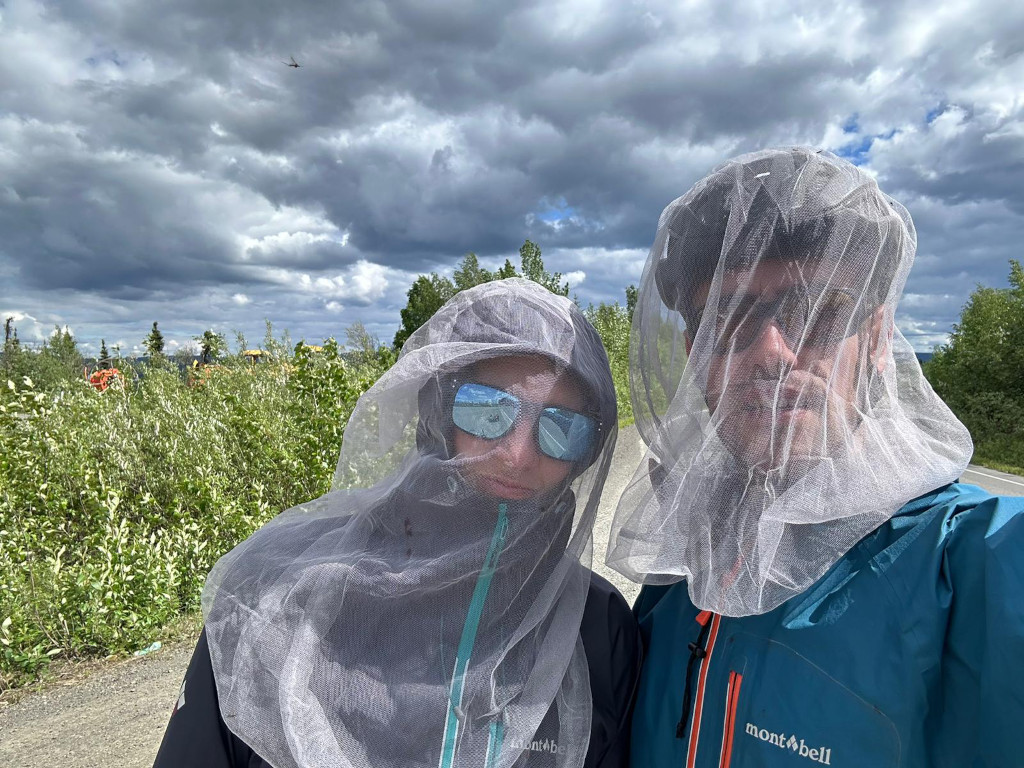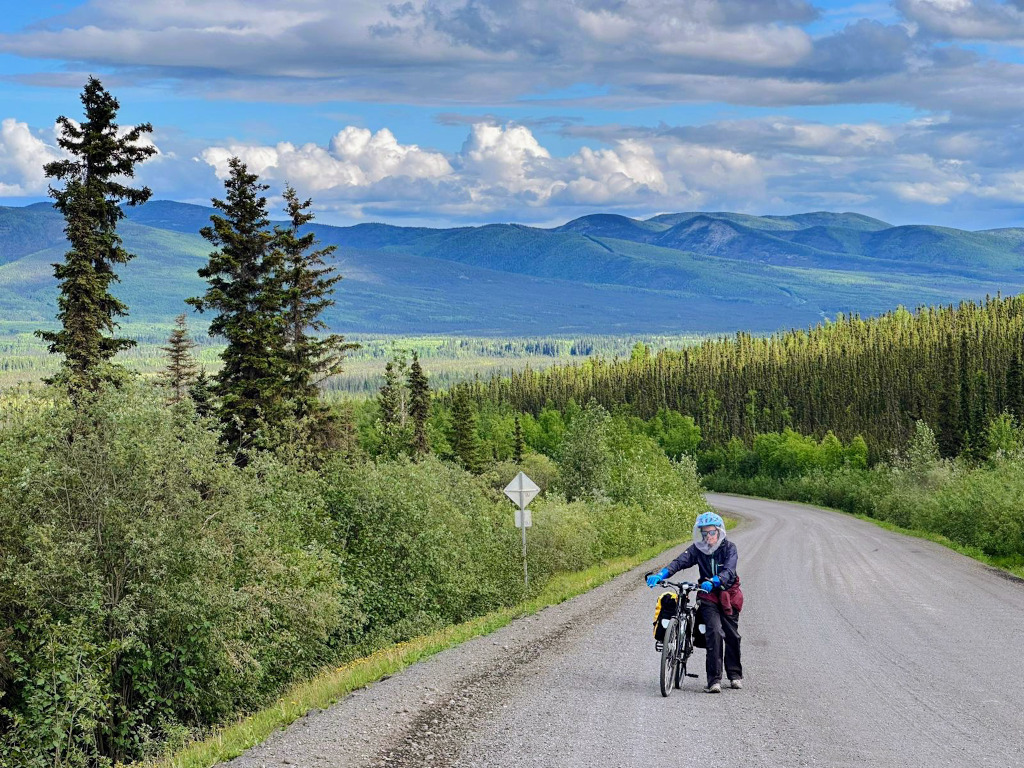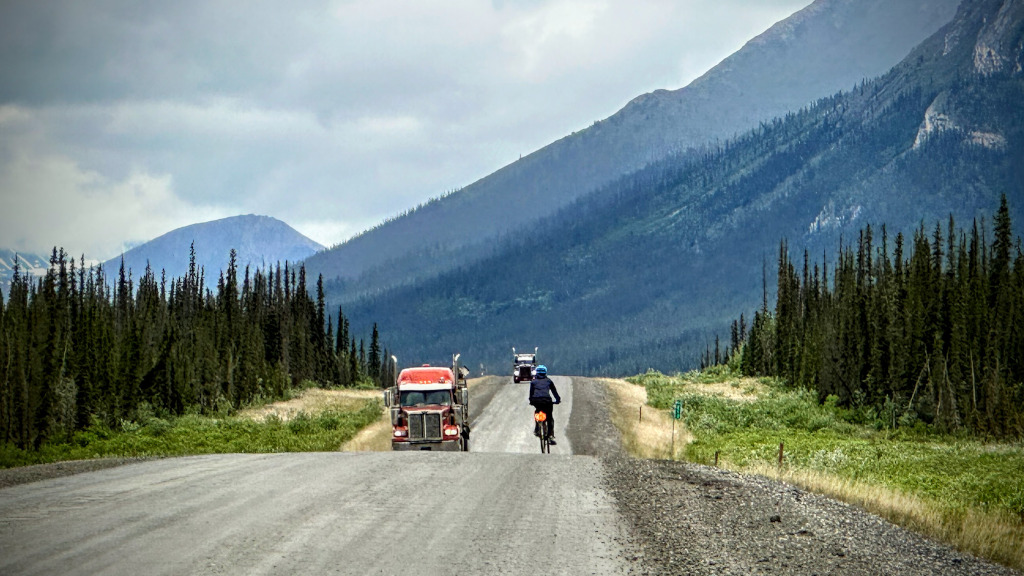The Haul Road
The next morning, we gorge ourselves on the breakfast buffet at the hotel, and Salomé goes back to bed. She is still exhausted from the previous day. When we finally leave the hotel, it is noon. Leaving Fairbanks is unpleasant on busy roads. As soon as we leave the city behind us, we bike on quiet roads through forest, it is pleasant. But the many hills we bike up and down tire us, and we set up camp before biking the full 45 mile daily goal in a pullout. The next day is very similar, more up and downs through birch and black spruce forests. Mosquitoes are ever present, and on the slow uphills we have to wear rain gear, head nets, and gloves to protect ourselves from them, massively overheating. It is beautiful, miles and miles through untouched forest (apart from the road). We feel small. Salomé struggles more and more with the uphills and begins to push the bike up the steepest sections to save energy. The last mile of the day we reach the Dalton Highway, also called the Haul Road. And it is where the pavement (mostly) ends. The road is bumpy, and our progress is even slower. We camp next to the iconic sign of the Dalton Highway.
As Salomé cooks a meager ration of food (we packed one day less of food than what we planned), she feels discouraged. It is hard for her to bike the planned 45 miles per day, especially in this hilly terrain. And now doing the same on unpaved roads seems impossible. We booked a cabin in Wiseman; she worries that we won’t get there in time. Deep in dark thoughts, a car stops, and a family gets out of the car for a photo. They frantically try to keep the mosquitoes away, spraying bug “dope” into the air around them. The father comes towards us and asks us what we are doing. We tell him that we are biking up to the Brooks Range and then will cross it on foot and with packrafts. He yells at us: “Are you right out of the nuthouse? It’s already dangerous to drive on this road, but you are crazy, you must have just left the nuthouse!” We are so surprised by his strong and angry reaction that we don’t know what to answer.
The next day is much easier. It is sunny, the road is not as bad as Salomé feared, and we don’t struggle as much. We get to a construction site where they force us to ride with our bikes on the back of the pilot truck for a few miles. The safety manager also gives us high-visibility vests, which add a splash of neon to our dusty selves; she is scared truckers won’t see us. Initially, we are disappointed to be forced to skip a section, but then we realize that we can make it to the Yukon River the same night. Fresh food becomes a huge morale booster, and we make good progress. We have been told that if you bike, paddle, or hike to Yukon Camp, a rest stop for truck drivers just by the river, you get a free meal. We look forward to this friendly place.
As we bike towards the gigantic Yukon River and the promised food, we are smitten by its beauty. A gentle giant, it makes its way through large, untouched forests. When we get to Yukon Camp, the owner greets us, excited about our adventure. We enjoy delicious fresh food and feel rejuvenated. Salomé notices that the difficult feelings she had last night were not so much about the day but more about the worry that “if I have a hard day today, if I suffer today, then I will suffer the same or worse the next day and the day after and after…”. Again and again during the whole trip, she will be shown that usually a good day follows a bad day, a bad day has no say in how the next day will be going.
Leaving the Yukon brings a lot of uphills and millions of mosquitoes. We have lunch for the first time inside the public toilet in the rest area, mostly free of mosquitoes and a bit more spacious than a porta-potty. Later, we learn that they were recently cleaned at the start of the tourist season, as they’re often impossibly disgusting. At the end of the morning, Salomé finds Ricardo waiting for her on the side of the road, in full rain gear, his hands in the headnet, trying to not get eaten alive by the swarms of mosquitoes. She then sees a person running towards Ricardo, who is completely unaware. It’s a Japanese guy, wearing running shorts, a kimono and traditional hat of rice farmers in Japan. Salomé yells: “Ricardo, turn around!”, knowing that the sight of this runner would lift his spirits. He’s running the length of the Americas, running 40-50 miles a day, and started in the Arctic just a few days ago. We exchange contacts and invite him to stay with us when he reaches Seattle a couple of months later (which he did!).
We hit a second construction site, where they drive us across, and learn that the rabid wolf has been shot. We feel relieved but also sad. We can’t help but think that we are in their territory, trucks and cars creating noise and dust. We can see how disturbing this must be for a wild creature, how it could attack trucks and cars in anger.
That night on Finger Mountain, we can see the peaks in the Brooks Range for the first time. It is beautiful! But the sight of these mountains worry us; there is snow in even lower hills. Will there be snow at the high passes we need to cross in a few days? Is it worth continuing? Then we remember that we have no guarantee to successfully finish this trip, but at least we are trying to fulfill this dream of ours. Mosquitoes are really bad that night, our tent is immediately covered. When we get out to pee, we cannot get inside the tent fast enough. But the tent zipper is starting to fail and refuses to close! We dearly need it for the next 30 days!
The next two days are much easier, flatter, and at times even on pavement. We make good progress and enjoy biking. A day later we reach Coldfoot, a truck stop with a few houses. We visit the interpretative center of the National Park to ask about conditions. The rangers have no useful information for us about the snow levels, or any routes in the park. Instead they warn us about hypothermia and take information about our route, tent, and backpack color in case of an evacuation. And the ranger tells us horrified how she had to deal with twenty mosquitoes that entered her car. We smile and say nothing, thinking of the previous night when Ricardo forgot to fully close the tent, and we woke up with hundreds of these insects in our tent.
We are excited to be in Coldfoot, again because of the food, the truck stop’s buffet is famous among travelers. And it lives up to its hype, a buffet with a large selection of fresh food. We fill our plates multiple times. We take the evening to research an alternate route in case we can’t cross the highest pass of our hiking section, Ariel Pass in the Arrigetch, which is already difficult and exposed without snow. After a copious breakfast at the truck stop the next morning, we ride fifteen miles to Wiseman on flat, easy roads, pushed by tailwinds.
We look forward to our stay in the cabin and spend most of our time organizing our food, washing our clothes, and resting. Uta and Bernie have built these huts themselves. They are charming and fit in well into this historic gold rush town. We enjoy the luxury of a bed and a warm shower. The next morning they prepare breakfast for us. We arranged for them to pick up our bikes that evening 56 miles north from Wiseman, where we will start our hike away from the road. Uta also tells us how lucky we were that our package arrived in time. Packages only get delivered once a week and often take 3 weeks from the lower 48. We talk about adventuring. As always, we are nervous about starting a new section. We are happy to have figured out biking. And the road, with its traffic, offers some safety because someone will pass us in case we need help. Once we start hiking, we’ll be on our own. Uta tells us: “It’s about trying and enjoying trying, not about succeeding.” We take this way of thinking with us. Bernie also offers us hooks and line to fish, in case we run out of food; graylings are easy to catch in clear pools of water.
We set off with light bikes, Uta and Bernie will bring our stuff later that day, and we breeze through the last 56 miles of the biking section, which follow a long valley deep into the mountains. We are not biking in the Brooks Range, it is gorgeous! Even though we stop many times to take photos, we make good and quick progress. In the evening, the odometer Ricardo installed in his bike shows that we have done 485 miles total on the bikes. That night, Salomé confesses to Ricardo that she has actually enjoyed the biking section, the section she dreaded the most.
